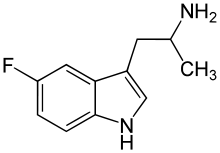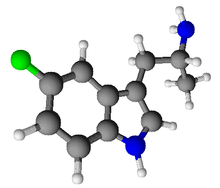5-Fluoro-AMT
5-Fluoro-α-methyltryptamine (5-Fluoro-αMT), also known as PAL-544,[1] is a putative stimulant, entactogen, and psychedelic tryptamine derivative related to α-methyltryptamine (αMT). It has been found to act as a well-balanced serotonin-norepinephrine-dopamine releasing agent,[1] a 5-HT2A receptor agonist,[2] and a potent and specific MAO-A inhibitor.[3][4] It produces a strong head-twitch response in mice, and this effect is known to correlate with psychedelic effects in humans,[5][6] which suggests that 5-fluoro-αMT could be an active psychedelic in humans, although it is not known to have been tested in humans and could be dangerous due to its strong inhibition of MAO-A.
 | |
 | |
| Identifiers | |
|---|---|
IUPAC name
| |
| CAS Number |
|
| PubChem CID | |
| ChemSpider |
|
| ChEMBL | |
| Chemical and physical data | |
| Formula | C11H13FN2 |
| Molar mass | 192.233 g/mol g·mol−1 |
| 3D model (JSmol) | |
SMILES
| |
InChI
| |
| | |
See also
- 5-Chloro-αMT
- 5-Fluoro-DMT
- 7-Methyl-αET
- Flucindole
- 5-API (PAL-571)
References
- Banks, M. L.; Bauer, C. T.; Blough, B. E.; Rothman, R. B.; Partilla, J. S.; Baumann, M. H.; Negus, S. S. (2014). "Abuse-related effects of dual dopamine/serotonin releasers with varying potency to release norepinephrine in male rats and rhesus monkeys". Experimental and Clinical Psychopharmacology. 22 (3): 274–84. doi:10.1037/a0036595. PMC 4067459. PMID 24796848.
- Chairungsrilerd, N; Furukawa, K; Tadano, T; Kisara, K; Ohizumi, Y (Mar 1998). "Effect of gamma-mangostin through the inhibition of 5-hydroxy-tryptamine2A receptors in 5-fluoro-alpha-methyltryptamine-induced head-twitch responses of mice". British Journal of Pharmacology. 123 (5): 855–62. doi:10.1038/sj.bjp.0701695. PMC 1565246. PMID 9535013.
- Kinemuchi, H; Arai, Y (Oct 1986). "Selective inhibition of monoamine oxidase A and B by two substrate-analogues, 5-fluoro-alpha-methyltryptamine and p-chloro-beta-methylphenethylamine". Research Communications in Chemical Pathology and Pharmacology. 54 (1): 125–8. doi:10.1016/0028-3908(91)90057-i. PMID 3797802.
- Kim, SK; Toyoshima, Y; Arai, Y; Kinemuchi, H; Tadano, T; Oyama, K; Satoh, N; Kisara, K (Apr 1991). "Inhibition of monoamine oxidase by two substrate-analogues, with different preferences for 5-hydroxytryptamine neurons". Neuropharmacology. 30 (4): 329–35. doi:10.1016/0028-3908(91)90057-i. PMID 1852266.
- Corne, SJ; Pickering, RW (1967). "A possible correlation between drug induced hallucinations in man and a behavioral response in mice". Psychopharmacologia. 11 (1): 65–78. doi:10.1007/bf00401509. PMID 5302272.
- Yamamoto, T; Ueki, S (Jan 1981). "The role of central serotonergic mechanisms on head-twitch and backward locomotion induced by halluinogenic drugs". Pharmacology Biochemistry and Behavior. 14 (1): 89–95. doi:10.1016/0091-3057(81)90108-8. PMID 6258178.
Further reading
- Nakagawasai, O; et al. (Jan 2004). "Monoamine oxidase and head-twitch response in mice. Mechanisms of alpha-methylated substrate derivatives". Neurotoxicology. 25 (1–2): 223–32. doi:10.1016/S0161-813X(03)00101-3. PMID 14697897.
Empathogens/entactogens | |
|---|---|
| Phenylalkyl- amines (other than cathinones) |
|
| Cyclized phenyl- alkylamines | |
| Cathinones |
|
| Tryptamines | |
| Chemical classes | |
| Adamantanes | |
|---|---|
| Adenosine antagonists |
|
| Alkylamines | |
| Ampakines | |
| Arylcyclohexylamines | |
| Benzazepines | |
| Cholinergics |
|
| Convulsants | |
| Eugeroics |
|
| Oxazolines | |
| Phenethylamines |
|
| Phenylmorpholines |
|
| Piperazines | |
| Piperidines |
|
| Pyrrolidines | |
| Racetams |
|
| Tropanes |
|
| Tryptamines |
|
| Others |
|
Serotonin receptor modulators | |||||||||||||||||||||||||||||||||||||||
|---|---|---|---|---|---|---|---|---|---|---|---|---|---|---|---|---|---|---|---|---|---|---|---|---|---|---|---|---|---|---|---|---|---|---|---|---|---|---|---|
| 5-HT1 |
| ||||||||||||||||||||||||||||||||||||||
| 5-HT2 |
| ||||||||||||||||||||||||||||||||||||||
| 5-HT3–7 |
| ||||||||||||||||||||||||||||||||||||||
| |||||||||||||||||||||||||||||||||||||||
|
This article is issued from
Wikipedia.
The text is licensed under Creative
Commons - Attribution - Sharealike.
Additional terms may apply for the media files.